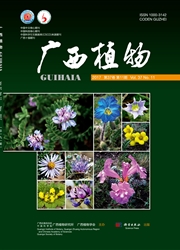

 中文摘要:
中文摘要:
柏科植物是园林绿化中常用的常绿树种,具有种数多、分布广的特点。该研究采用水蒸气蒸馏法提取5种柏科植物叶片中的挥发油,利用气相色谱-质谱(GC-MS)与计算机检索联用技术对其化学成分进行分析和鉴定,并用面积归一法测定各组分的相对含量。结果表明:用水蒸气蒸馏法提取柏科植物挥发油得油率较高,除偃柏外4种柏树的得油率都在0.5%以上;5种柏科植物挥发油中共检测出了80种萜类物质,其中日本花柏中萜类物质最多含有54种,日本扁柏次之含有51种,柏木含有47种,线柏含有42种,偃柏则只含有35种;挥发油中含量较高的成分有乙酸龙脑酯、α-蒎烯、3-蒈烯、D-柠檬烯、松油烯-4-醇、桧烯和萜品油烯等,一些植物还含有龙脑、β-月桂烯、石竹烯、β-紫罗兰酮和Verticiol等一些重要的药用成分;柏科植物挥发油具有成分及相对含量差异大、成分较简单、化合物种类以萜烯类为主的特点。研究结果可为进一步开发利用柏科植物资源提供理论依据。
 英文摘要:
英文摘要:
Cupressaceae is the only cosmopolitan family of conifers, containing nearly 150 species widely distributed all over the world,and many of which are important horticultural plants. At present, there are quite a few researches which attempt to survey diverse applications of these plants, but few researches focused on studying the essential oils of these species. In this study, the essential oils of five Cupressaceae plants (Chamaecyparis obtusa ,Cupressus fune- bris, Sabina chinensis var. sargentu, Chamaecyparis pisifera cv. Squarrosa Ohwi and C. pisifera ) were obtained by hydrodistillation from fresh leaves, which were furtherly analyzed by gaschromatography-mass spectrometry (GC- MS) and database retrieval. The result showed that hydrodistillation was an effective method for extraction the essen-- tial oils of these plants. Except for Sabina chinensis vat. sargentu ,the oil yielding rate of four other species were more than 0.5%. Totally 80 compounds were identified from these essential oils, and most of which were terpenoids. Chamaecyparis pisifera contained the most number of compositions, about 54 kinds, then followed by C. obtusa, C. funebris and C. pisifera cv. Squarrosa Ohwi, containing 51,47 and 42 kinds respectively, while there was only 35 constituents in Sabina chinensis var. sargentu. The main constituents of the essential oils were bornyl acetate,α-pi- nene, 3-carene, D-limonene, terpinen-4-ol, sabinene, terpinolene etc., and some consitituents were valuable for pharma- ceutical industry, such as endo-borneol, β-myrcene, caryophyllene, β-ionone and verticillol. The compositions of the es-sential oils and their relative contents in five plants were very different, and up to 50 % of the total compounds were u- nique compositions contained only in one or two species. The constituents present in all five plants were less than a quarter of the total compounds. The study can provide reference basis for development and utilization o{ germplasm resources of the family Cupressaeeae.
 同期刊论文项目
同期刊论文项目
 同项目期刊论文
同项目期刊论文
 期刊信息
期刊信息
